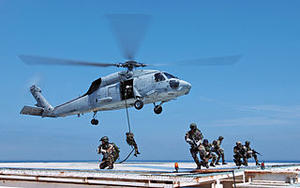TerrorismGreater role for Pentagon in next phase of U.S. war on terror
The Obama administration had dramatically increased the use of drones in the war against terrorists. The number of drone strike has declined this year relative to the high levels of 2010-11. The number of drone strikes may increase again, but this past weekend’s Special Forces raids in Somalia and Libya are an indication that the next phase in the U.S. war on terrorism would see, in relative terms, less of a reliance on CIA-operated drones and a greater role for the Pentagon.

Navy SEALs during insertion drill // Source: commons.wikimedia.org
The Obama administration’s dramatic increase in the use of drones in the war against terrorists has drawn criticisms from both liberals and conservatives. Liberals complained that the use of drones resulted in too many civilian casualties, leading to growing anger against the United States among people who lived in areas where terrorists operated. Some conservative commentators argued that the Obama administration had increased its reliance on drones in order to escape the need to address the tricky issue of what rights detained terrorists should enjoy (“Obama has avoided vexing detention issues simply by depriving terrorists of all of their rights — by killing them,” wrote John Yoo, who served in the Bush Justice Department).
The steady increase in the use of drones came to end this year. In the past several months, the United States has reduced the number of drone strikes on terrorist targets in Pakistan and Yemen: the United States launched 117 drone strikes in Pakistan in 2010, compared to twenty-one so far this year.
The reduction in the number of drone strike was accompanies by a speech in May this year by President Obama, in which he warned against making the war on terrorism an open-ended war.
Whether or not the increasing level of terrorism in Africa has caused the president to change his view of the war on terrorism, and whether or not the United States would increase the number of drone strikes to the 2010-11 level, remain to be seen.
This past weekend’s Special Forces raids in Somalia and Libya, however, are an indication that the next phase in the U.S. war on terrorism would see, in relative terms, less of a reliance on CIA-operated drones and a greater role for the Pentagon.
The Los Angeles Times reports that this was the message from U.S. officials on Sunday.
“Rendition” – the grabbing of suspects on the street of a foreign city, keeping them in secret “black sites,” and applying “enhanced interrogation” techniques to them – was the province of the CIA.
For the U.S. military to capture a suspect in the capital of a country in which it is not conducting military operations “is extremely rare,” one senior congressional aide told the Times.
“I think this goes along with this policy that they are trying to move counter-terrorism operations from CIA to Defense, and trying to operate less with drones,” said the aide, who spoke on condition of anonymity.
Caitlin Hayden, a spokeswoman for the National Security Council, praised the “exceptional work” of U.S. military and intelligence agencies in capturing Abu Anas al Liby, who is now being held on a U.S. Navy ship.
President Obama “has made clear our preference for capturing terrorist targets when possible, and that’s exactly what we’ve done in order to elicit as much valuable intelligence as we can and bring a dangerous terrorist to justice,” Hayden said.
“This operation should be a clear reminder that the United States will seek justice against those who would attack Americans, and never forgets those who are victims of terrorism,” she added.
